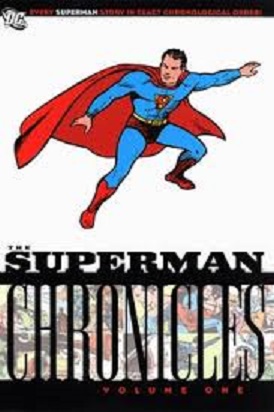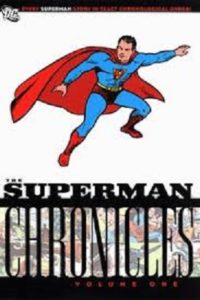Comic Book Review: The Superman Chronicles Volume One by Jerry Siegel and Joe Schuster
While there were several precursors to Superman, he’s generally agreed to be the first full-fledged comic book superhero. Superhuman abilities, a distinctive costume, and a dual identity, he had them all. When Superman first appeared in Action Comics #1 in 1938, the readers had not seen anything quite like him before, and the comic book flew off the shelves.
However, the fellow who appeared in those early issues wasn’t quite the Superman we’ve come to know after all these years. The “Chronicles” series of reprints gives us full-color reproductions of the stories in order of publication, starting with the very first, plus the covers of the issues.
Action Comics #1 starts us off right with the classic scene of Superman smashing a car into a rock, which turns out to actually happen in the story. The feature begins with an abbreviated version of Superman’s origin. The dying planet that sent a single rocketship to Earth (not yet named Krypton), a passing motorist (not yet identified as the Kents) who takes the infant to an orphanage, his growing powers (strength, speed, leaping, nigh-invulnerability) and his determination to use his powers to help those in need. Clark Kent’s powers are explained by his physical structure being far more advanced than Earth humans, giving him the proportionate abilities of an ant or grasshopper.
The story itself starts in media res, as Superman carries a murderer to the governor’s mansion. Leaving her tied up nearby, the Man of Steel forces himself past the governor’s servant, and through a metal door to that worthy’s bedroom. He produces proof that the woman about to be executed is innocent, and stays right there until the governor pardons her.
The next day, Clark Kent is pleased to see that the Daily Star did not print anything about Superman’s involvement. But the rumor of a superhuman fellow in a bright costume has already come to notice, and the Star’s city editor puts his rookie reporter Kent on the job of discovering the truth.
Kent learns of a wife-beating in progress, but it’s Superman who appears at the scene and roughs up the abusive husband. The cad faints, and it’s Clark who greets the police.
Next, it’s time to establish the “mild-mannered” part of Clark Kent’s persona. Clark convinces fellow reporter Lois Lane to go dancing with him, but she’s showing a distinct lack of enthusiasm. When Clark backs down far too easily to a hood named Butch who cuts in, Lois is disgusted at his cowardice and leaves the dance hall.
Butch is angered by Lois’ refusal to dance with him, and sets out to abduct her with a few of his criminal friends to teach Lois a lesson. Naturally, Superman shows up and the cover scene ensues. The Man of Tomorrow carries Lois home and advises her not to tell anyone. Sure enough, the next day, no one will believe her wild story. It will take her a couple of issues to fully process her reaction to Superman.
The Star’s editor has a new assignment for Clark Kent. South American republic San Monte is having a civil war, and since the home front is getting so dull card games are front-page news (I am now imagining a 1930s version of Yu-Gi-Oh), Kent should go down there and file some war reports. Oh, pictures would be good too.
Rather than head directly south, Kent first travels to Washington, D.C. He spots a Senator Barrows being furtively contacted by lobbyist Alex Greer, who’s known to be connected to “dark money” but no one knows whose. Eavesdropping on their next meeting, Superman learns that the bill Senator Barrows is pushing is designed to entangle America in European affairs. (We never come back to this plot point.)
Afterward, Superman approaches Greer to find out who his backer is. Naturally the lobbyist declines to state this information, so Superman picks the man up and starts leaping all over town with him. He even finds time to impart a science fact about birds and power lines! His last leap doesn’t quite make it to the next building, and the men begin to fall….
All that in thirteen pages!
Action Comics #2 does not have Superman on the cover; he would not make it back until #7, and thereafter would usually be mentioned in a text box even if the cover was of someone else.
The story picks up where #1 left off, with Superman and Greer landing on the sidewalk. They survive, the sidewalk doesn’t. Greer spills the beans on his boss, international arms dealer Emil Norvell. Superman then uses his considerable persuasive powers to make sure that Norvell travels to San Monte and enlists in their army.
Lois is assigned to go along with Clark Kent to South America. Lots of things happen, including Norvell learning what it’s like to be on the pointy edge of his munitions, Lois nearly being shot as a spy, Superman just straight up killing a torturer (oh sure, we don’t see him land, but being tossed several miles away? He’s not going to have a soft landing) and the Man of Steel finding a creative way to stop the war.
The story is followed by an advertisement for the daily Superman comic strip, soon to come out.
#3 has Superman get a neglectful mine owner to improve safety conditions for workers. (Some ethnic slurs by baddies.) There’s also an announcement of the first Superman fan club, the Supermen of America.
#4 is Superman kidnapping a college football player for several days to impersonate him in order to prevent a game from being fixed. As a side effect, it also improves Tommy’s love life.
#5 has Lois Lane get enraged by the editor’s sexism (“no job for a girl”) and trick Clark Kent into pursuing a fake story while she goes off to cover a bursting dam. Superman saves Lois a couple of times and she admits her feelings for him while still despising Clark.
#6 is the first Superman impersonator story. A crook dresses his henchman up in a Superman suit and has him do faked stunts of superstrength so that the crook can claim he’s got a legal license to sell Superman merchandise. Lois easily sees through the fake, but still needs rescuing. Also has the first Superman-themed song.
#7 has Superman join a failing circus to give it an attendance boost, and reveal the criminals that are trying to take it over. This is a good spot to mention that Superman’s distinctive costume was partially based on a circus strongman outfit, including trunks worn over tights to keep certain body bulges smoothed out. This story also introduces Curly, the first of what would be a recurring type of bully who also works at the paper and pranks Clark Kent. By the end of the story, Clark finds a way to get some payback.
#8 is another classic moment for Superman as a social justice warrior. He decides to tackle the problem of juvenile delinquency in slum kids–by tearing down the entire slum, thus forcing the government to build them new housing ala FEMA!
Of course, actions have consequences, and in #9, the police bring in Chicago cop Detective Captain Reilly, known as “100% Reilly” for always getting his man. Reilly’s plan hits a significant snag when he attempts to chisel an informant out of the substantial reward money promised. Clark Kent is barely able to escape detection, but at the end, the visitor is known as “99% Reilly.”
#10 is another social justice story–Superman goes undercover as a prisoner to expose inhuman conditions imposed by a crooked warden. (Warning: torture.)
#11 continues Superman’s impersonations. To expose a crooked oil company, he poses as investor Homer Ramsey and contrives a beautiful scam where he tricks the oil company executives into trading their real money for their own worthless stock. Environmentalists may cringe at how he does it, though. (Presumably Superman turns the money he made over to charity.)
#12 has an interesting Zatara cover with a nifty spaceship. The Superman story has him getting angry at reckless drivers and automobiles that are unsafe at any speed. So he imposes a reign of terror on the city. (And admittedly, fixes a particularly bad stretch of road.) You can just feel Siegel’s outrage boiling off the page as Superman refuses to use doors in his pursuit of strict traffic enforcement. Also in this issue, an announcement of DC’s second superhero, the Batman!
New York World’s Fair #1 ties into that 1939 event. Clark and Lois are sent to cover the opening, but Superman spends most of his time helping attractions open on time and thwarting a criminal plot.
Action Comics #13 starts its story with Superman fighting the “Cab Protective League”, a shakedown racket aimed at taxi drivers. However, we soon meet the first ever evil mastermind to battle Superman. The Ultra-Humanite is a bald scientist who has given himself super-intelligence (which may or may not have anything to do with his paraplegia.) Moriarty-like, he’s been secretly behind some of the criminal schemes Superman has thwarted.
His vast knowledge of science allows the Ultra-Humanite to stun Superman, but not kill him. The evil scientist then appears to die in a plane crash, but Superman is unable to find a body. He’ll be back several times, until Lex Luthor takes over his ecological niche.
And the volume concludes with Superman #1, as Superman became the first superhero to have his own solo comic book. Most of the contents were reprinted from Action Comics #1-4.
However, the first story had a new introduction naming Krypton and the Kents for the first time, and establishing that John and Mary Kent had passed away from old age after training Clark in American values. We then see how Superman learned of the innocent person condemned for murder and where to find the murderer seen in the first story.
The explanation of Superman’s powers now explained that Earth’s lighter gravity aided his advanced body structure to perform his superhuman feats.
Finally, there’s a two-page text story. These prose stories appeared in comic books to force the post office to classify them at a lower postal rate. Usually, they weren’t very good. No exception here.
The art is crude but dynamic, and it’s fun to watch Superman perform his many feats. This is a rougher-edged fellow who very much has opinions, and isn’t afraid to take matters into his own hands. Soon he’ll calm down a bit and become more authority-friendly (and develop a code against killing.) No more random kidnappings!
Highly recommended to Superman fans and those who want to know more about the early history of superhero comics. Check your library!


